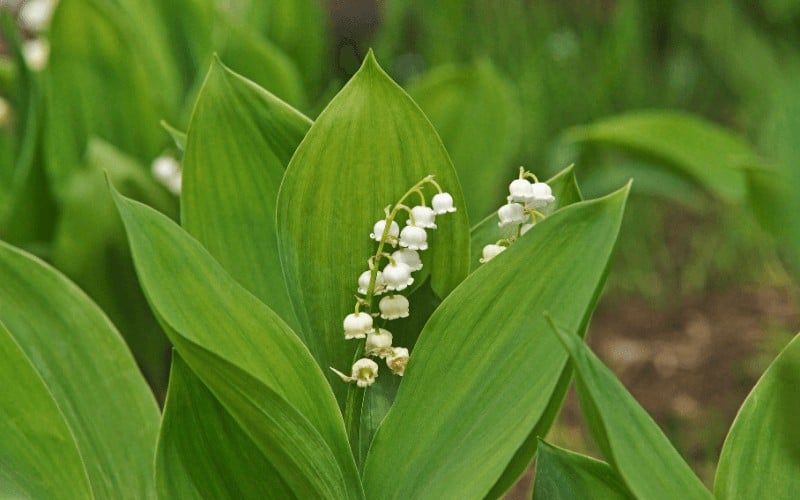Identifying what plants grow from rhizomes isn’t so difficult. There are a good number of plants that grow from rhizomes such as iris, turmeric, bamboo, etc., and you're going to learn more about these plants today.
Rhizomes are modified stems that grow underground horizontally. They sprout new roots from their nodes down into the soil and also shoot new stems above the surface of the soil. This underground plant parts store nutrients as well.
Rhizomes are different from roots; they have buds, from which they emerge new shoots, but roots do not have buds, they primarily hold the plant into the ground.
Below, we're going to show you some of the plants that grow from rhizomes:
Table of Contents
What Plants Grow from Rhizomes?
1. Ginger rhizome (Zingiber officinale)

Ginger which is commonly called ginger root is one of the plants that grow from rhizomes. The rhizome is the edible portion of the plant.
The two major varieties of ginger are the Chinese or common ginger. They are usually imported from China or India and they are mostly named after the area where they are grown like Rio de Janeiro, Guangzhow, Nadia, etc.
There are also ornamental gingers that produce beautiful and attractive foliage such as Hedychium and Curcuma.
Propagation of ginger rhizomes is not much of a difficult task. You can even plant the ones you buy from a local grocery store. Cut into different sizes and ensure each cut has at least a bud (node) where it can sprout out.
Ginger has several benefits ranging from health to culinary uses as spices.
2. Sword Ferns

In other types of plants, rhizomes also serve the same function on ferns as root systems.
Ferns are naturally known to be hardy and can reproduce by the rhizomes or by spores that grow below the leaves.
You can propagate using any of the methods (through rhizomes or spores). Although much easier, is through the rhizomes.
Sword fern can easily be propagated by cutting the rhizomes either when the fronds turn yellow during fall or as soon as the plant has new growth at the beginning of spring.
Make a hole in the soil with your forefinger or with a garden trowel, the hole should be bigger than the rhizome you want to plant.
Carefully place the rhizomes or fronds in the soil and cover with soil ensuring that the rhizomes are not destroyed. If you are growing in a pot, keep it under a shade.
3. Iris

Irises are yet another type of plant that grows from rhizomes. There are about 300 species in the genus Iris but the most common irises are the tall bearded ones (Iris germanica). It is named after the Greek goddess. They come in many beautiful colors.
Bearded irises are called so because of their softness along the center of the falls, and in the crested iris, the hairs form ridge or comb.
The best time to propagate iris is in late summer to early fall during which night temperatures often remain between 40 and 50 degrees.
Iris flower has six petals. The three outer hanging petals are called “falls” while the inner upright petals are called “standard”.
Irises bloom best in full sun. So, they need enough sun to thrive well.
4. Convallaria

Convallaria also known as Lily-of-the-valley can grow from rhizomes. To grow convallaria, cut them when dormant during spring or fall so that they will sprout out.
Dig up small rhizomes called pips and carefully separate them, and then replant at least 4inches apart.
5. Bamboo

Bamboo is a perennial member of the grass family that grows in several climates. Some can withstand very low temperatures while others will only do well in tropical areas.
A bamboo plant starts with one culm or stem but as it grows into maturity; it begins to develop more rhizomes.
It will take many years for the root mass to mature, but once it is matured, the grove can spread fast.
6. Turmeric

Turmeric belongs to the family of ginger. It is a common spice used across the world.
Turmeric rhizomes have dark orange color but slightly brighter in color when processed into powdered form.
Apart from its culinary uses as spices, turmeric is also sometimes used to color fabrics like cotton, silk, and wool.
Turmeric has several health benefits and it can be processed into powdered or liquid form.
Propagation of turmeric is mostly through the seeds. You can sow the seeds on a well-drained medium and keep them in a dark place.
Germination times vary widely but within 20 days of planting, the seed will germinate.
You can get the roots from any local grocery shop to plant. Sow them in the tray and cover them. As soon as the root starts to bring outshoots, then remove the seed stray from where it has been and plant the sprouting seeds in a warm place that is protected from direct sunlight.
After that, plant the rhizomes deep in the soil about 2-3 inches, and ensure the soil is warm. In most locations, spring and fall are the best times to plant turmeric.
Conclusion | Plants That Grow From Rhizomes
A rhizome is a modified stem that runs underground horizontally. When you plant rhizomes, they strike new nodes into the ground and as well shoot up new stems up to the surface from their nodes.
Other plants that grow from rhizomes are interrupted fem, plume poppy, wall germander, Virginia creeper, yellow archangel, heavenly bamboo, border grass, Chinese lanterns, etc.
With this article, we have been able to determine what plants grow from rhizomes. Although the number of plants highlighted in this article is not all there is as to the number of plants that grow from rhizomes.
Related Posts:
- Virginia Creeper Vs Poison Oak
- Plants With Waxy Leaves
- Plants With Red Stems
- Plants That Grow Well Together In Pots
- Hoya Krimson Queen Vs Princess




